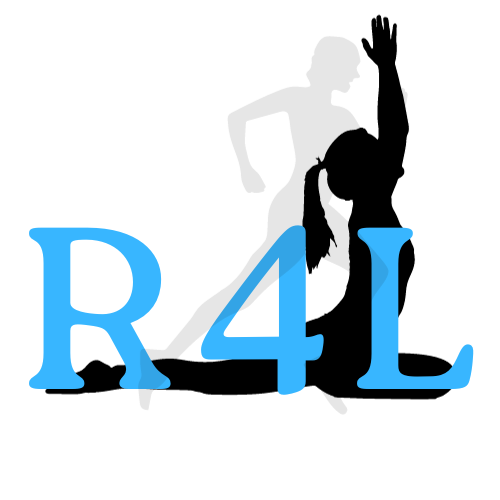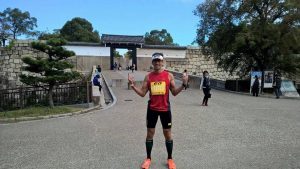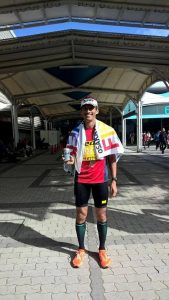This article is the first of Run4life #bigkidmoment series.
This series of articles will feature people talking about their big kid moments. Describing their motivation, their preparation or lack of, and finally how they felt after having done their #bigkidmoments.
In this article I am featuring Ironman EV, an inspirational trainer and athlete. Some weeks ago, Ironman EV ran the Osaka Marathon, before jetting back home to assist me in leading the warm up session at the Urgent Run 2016.
Several years ago, Michelle, a very good friend used the term ‘big kid moment’ when she congratulated me after I had completed one of the marathons, that I have been blessed to have participated. I have come to use this term to describe taking time for ourselves.
Big kid moment, every one should have these, are moments we take for ourselves to indulge in things we love. It is us doing something special, extraordinary and exhilarating. Doing something a kid would do on a whim, because that is what kids do. As adults, with our hectic schedules, working hard to provide for our families, we sometimes forget that we were once kids, carefree in taking chances and enjoying ourselves. I have come to realise that these big kid moments are just as important as working hard to provide. It is not being selfish. On the contrary I think these #bigkidmoments are just as important. For, if we do not take care of our own well being, we suffer, who then takes care of our families?
#bigkidmoments are life inspiring, confidence boosting, and an overall feel good drug. It can be anything for example achieving a head stand, touching a spider or sky diving.
I hope that by reading about these moments you will be inspired to reignite your passion for life and be once again the kids you were. Then take action to plan, prepare and indulge in your own big kid moment. I assure you, you will come back recharged and more motivated to perform at work.
Ironman EV had posted the following notes to his FB page and have graciously allowed me to reproduce this here, as it was written.
I completed the Osaka Marathon on 3 November. In that race, I earned a Boston Qualifier (BQ) time of 3 hours 19 minutes. With a margin of over-10 minutes, I think I am assured of a spot in the Boston Marathon 2018. I was mildly disappointed that I missed narrowly a BQ-with-Boston in April this year. So, I applied for a place in this marathon after talking to participants from previous editions, including team-mates and representatives of Mizuno Asia.
When I earned a lottery spot, I was elated and made preparations: mainly in this order – accommodations, air-tickets, and race preparation.
Osaka Marathon was my third marathon after Boston Marathon and Challenge Roth (an Ironman-distance race), and I had to ensure I banked in a potential BQ for my ‘three-peat’ entry into Boston Marathon 2018.
I arrived on Thursday evening, collected my race-pack/registration on Friday, and raced on Sunday. It was a straight-forward process, with no fanfare or drama. That was the way I like my race preparation. The #MIZUNO Merchandise Store met us, upon exiting the racket collection points, and a wide array of shoes and race-gear greeted us. I was smitten by the Made In Japan (MIJ) Wave series of shoes, especially the Wave Emperor that I BOUGHT A PAIR the day after the race – at Mizuno’s flagship store in Osaka. The Bio-Gear (BG) series of compression-wear was also a new array, and many runners wore it on race-day.
Thus, when traveling with my team-mates Nicholas and Chor Yin – we knew each other for about 6 years – and we met up on two occasions before the race to tighten our race-plans. We did not, however, train together as I was training seriously with my F1 team-mates and Garmin pace-setters group. That I got mildly injured before three weeks before the marathon (a left gluteus maximus sprain) augured well for me as I did not have to jeopardise the training program of Nic and CY.
With a rigorous program of self-massage, stretching, and strength-conditioning, I recovered adequately to race on 3 November. I was still doing (and video-recording) my second cycle of the 22-Pushups/22-Day Challenge for awareness on physical disability and physically-challenged (PC) athletes. This motivated me to stay healthy and focused on my primary and secondary goals.
After an early-breakfast at 5am – sweetbread, and two cups of Bullet Coffee (I brought my own coffee and coconut oil with me to mix), I ‘took care’ of my body, facilitated by the Bullet Coffee. I visit the toilet as frequently as I can before I traveled to the race-site, as the queues tend to be reliably long and frustrating. I wanted to urinate one more time before I walked to the race-start, to do my warm-up and dynamic stretching. I also drank a cup of Hammer Nutrition ‘Perpeteum’ on my way out.
CY was kind to gently prod me, and informed me that ‘open-door’ urinals were located on the other side of the field. Thankfully, I visited it, and then we three soon parted ways as my race-pen was on the other side of the race-ground. As you walk pass the stadium, you will meander around the medieval Osaka Castle, which provided some relief to my pre-race anxiety.
Ironman EV
I managed to find my way into the ‘B-pen’ or second pen, by climbing over the rails. Interestingly, the runners did not demonstrate their upset-ness with me. Such was the zen-like readiness of runner before the flag-off. Around me, I glimpsed runners in all forms of attire, including those in costume. Halloween is celebrated with gusto in Japan, and saw several Pikachus, a Playboy Bunny, anime characters, and the like. Thinking back, they must have felt hotter with the additional gear most of us wore: singlet, shorts and shoes. I was dressed in Mizuno sleeveless top, 2XU running-tights, Mizuno Cruise 10 shoes, and BV Sport compression socks. I stuffed my small hand-held bottle of Hammer Nutrition ‘Perpeteum’ sports mixture in my side-pocket. The thermometer read about 12-17 degrees Celcius at dew-point with50-60 percent humidity, and would hit 20 by midday. The temperature is ideal for racing especially if you come from the tropics.
When the gun went off, I just ran slowly to gain my bearings and cadence. The synchronicity of runners encouraged me to take it easy for the first few kilometres. But it was not to be. Checking my Garmin 310XT watch after each KM, I noticed I was hitting 4:20-4:25 minutes/KM average. I tend to run intuitively – by ‘feel’ – and I use my watch as a guide for my pace. In racing, I tend to weave through any ‘gaps’ between runners. It is akin to swimming in open-water (sea, lake), where you swim to open patches of water, so that you do not get kicked by nervous swimmers.
The spectator support was great – cheering us, and their friends on. I was in race-mode and had my ‘game-face’ on, and spend most of my time looking just ahead of me. I was aware of the ‘general picture’, however focus more on my breathing, footfall and sense of discomfort. My triathlon friends, Marco and Fritz say that I think too much. That means I take a calculated approach to racing, whilst not taking the occasional risk. When you are too cerebral during a race, it plays on your mind, turning the supposed fun and festive event into a more challenging one. Constantly reminding myself of my preference, I nudged myself to, occasionally, pay heed to the runners around me, the next aid-station, and to appreciate how far my training had brought me.
CY called out to me at the 15km mark, where I returned my recognition. I was quite stoked for having nice splits on the 5km, 10km, and 15km milestones. I was, on-target, for a 3:08-3:09 marathon. My 21km split was good for a 3:10 marathon, and I hoped I could hang in. The prevailing belief among runners is that ‘the marathon does not begin until you experience fatigue, or ‘hit the wall’ or ‘experience the bonk’. True to prediction (I knew that my less than optimal tapering preparation would cost me), I started to slow down and felt ‘hotter’ at the 28km mark. One week before this race, I had almost no running until 12 hours before the race. A short run on the road/treadmill before the marathon or triathlon has always been my pre-race ritual.
The course is, generally, flat with several ‘switchbacks’ (U-turn points). The climbs are gradual, except for the one at the 38km mark.
As I hauled ass, I tried to dodge the bullets of fatigue by consuming nutrition at every aid-station. I used the Swiss-made CrampFix electrolyte-capsules at every 10km interval. The CrampFix electrolyte formulation has helped me for many years as I was feeling tight, but not cramping at all.
The ‘mountain’ came at the 38km when we had to crest a flyover. It is akin to the early part of the Sheares Bridge in the Singapore Marathon. Having trained for it, I ran up with stronger steps until I hit the plateau, and to a welcomed descent. The last four KM’s were just pushing the pace as hard as I can, although my speed was waning and I was wanting of more speed.
I was delighted to cross the finishing-line (as well as relieved), as I was ‘hauling ass’. Having braved fatigue after the 28km mark, and knowing that my desired goal of a 3 hour 9 minute finishing-time (PB/PR) was fading, I just gutted it through. I ‘dug deep’, focused on my secondary goal (BQ). It was a long examination that exhausted me physically and mentally. [Watch my video to see more slow-motion action.]
Ironman EV and his signature finish line salute
Like the race-exposition, everything was clockwork-precise, and I took my post-race celebratory photos, got my mini-red-bean bun, and bottle of sports-drink. On emerging from the vast hangar of a hall, I was pleased to get a free can of Asahi Beer. Alas! It was a non-alcohol version, which meant my pain had to be soothe much later at dinner in the Kirin City café and pub. I ate a bento set meal that helped my recovery, as I awaited Nic and CY.
An Asahi immediate post race recovery drink, non alcoholic 😉
Key Learning Points:
1) Choose a marathon/race that meets your goals.
2) Study the route before you decide on the race. Talk to previous participants and hear their feedback and opinions (ease of earning a BQ, PB/PR, course profile, spectator support, aid-stations, sideshow carnivals).
3) Choose a marathon/race that your body feels most comfortable with.
4) Travel with people you are comfortable with. Manage team dynamics well.
5) You want to enjoy the environment: scenery, touristy sights, and climate (time of the year).
I won’t go into detail with my post-race celebration and recovery. Suffice to say, I enjoyed eating Japanese cuisine and it was ‘comfort food’ to me. Drinking all the main brands of beers – Asahi, Sapporo, and Kirin – was part of my intended experience. It is hard to erase my passion for beer (even the zero-alcohol, Asahi Dry Zero beer) after spending 7 years working in a brewery. Visiting the fish markets in Osaka and Kyoto were highlights, as was walking through the renowned temples and shrines. There is a certain zen-like quality to the Japanese environment and scenery, which blends innocuously well with the polite and courteous citizens. I felt no need to rush when we went on walkabout, as I did also during my race. Racing with the Japanese runners, I learnt to appreciate the natural synchronicity and surrender to the ‘flow’. You need not rush, as you are still ahead and somewhere.
Thus, I recommend this race for the aforementioned benefits. I would give both Gold Coast Marathon and Osaka Marathon as my go-to races for a Boston Qualifier. Be mindful of the later start-times, and impending heat.
I hope that you found this report useful.
*Updates: Suffering symptoms of common cold a week AFTER the race. Last Saturday, I earned a season’s best 5km performance of under 21 minutes. So, in a sense the recovery is on-track, but mired with a few expected obstacles. No training for a few more days.*
Key Learning Points from Ironman EV:
1) Choose a marathon/race that meets your goals.
2) Study the route before you decide on the race. Talk to previous participants and hear their feedback and opinions (ease of earning a BQ, PB/PR, course profile, spectator support, aid-stations, sideshow carnivals).
3) Choose a marathon/race that your body feels most comfortable with.
4) Travel with people you are comfortable with. Manage team dynamics well.
5) You want to enjoy the environment: scenery, touristy sights, and climate (time of the year).
Inspired yet? Speak to Enrico or come run with me



